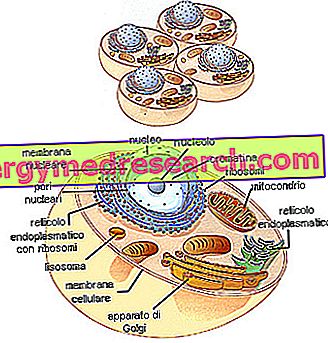THE GOLGI APPARATUS
It is a complex of smooth membranes collected to form flattened sacks (cisterns or saccula) leaning against each other and often arranged concentrically, enclosing portions of cytoplasm rich in vacuoles.
The edges of the cisterns, especially in the vegetables, are jagged; often, parts of them detach to form vesicles, which are small cavities enclosed in a membrane. The proteins synthesized to be secreted, formed on the ribosomes at the surface of the endoplasmic reticulum, are channeled into the Golgi bodies where they are accumulated and enclosed in vesicles. These vesicles are then transported up to the outer cell lining, then released outside the cell.
Today we tend to believe that the Golgi membranes are dynamically connected to the lattice both smooth and wrinkled, and also to the nuclear envelope. However, they constitute a distinct morphological entity: they provide, in fact, for the synthesis of polysaccharides and saccharide portions of conjugated proteins.
THE CENTRIOLI
The centrioles appear as cylindrical bodies of 0.2 micrometers in diameter which contain, within them, nine tubules each consisting of groups of three sub-units. The centrioles are usually in pairs in the cytoplasm, close to the nuclear membrane; one is called father, the other child (because he is believed to come from the first). The centriole pairs are arranged at right angles to each other in the cytoplasm, and are found only in those groups of organisms that also have cilia, or flagella. The centrioles, which are structurally identical to the basal bodies, are important in organizing the spindle, which appears during cell division and is involved in the movements of chromosomes.
The centriole is often surrounded by a layer of differentiated cytoplasm and this set is called centrosome. The centrosome is in charge of structuring the cell at the time of the division. In plant cells, however, the centrosome has no centrioles.

Click on the names of the various organelles to read the in-depth analysis
Image taken from www.progettogea.com
Edited by: Lorenzo Boscariol



